
A | B | C | D | E | F | G | H | CH | I | J | K | L | M | N | O | P | Q | R | S | T | U | V | W | X | Y | Z | 0 | 1 | 2 | 3 | 4 | 5 | 6 | 7 | 8 | 9
This article needs additional citations for verification. (May 2024) |
| Tamil | |
|---|---|
| Tamiḻ | |
| தமிழ் | |
 The word "Tamil" in the Tamil script | |
| Pronunciation | [t̪amiɻ] ⓘ |
| Native to | India and Sri Lanka |
| Region |
|
| Ethnicity | |
Native speakers | L1: 79 million (2011–2019)[1] L2: 8 million (2011)[1] |
Early forms | |
| Dialects | |
| |
| Signed Tamil | |
| Official status | |
Official language in | |
Recognised minority language in | |
| Regulated by |
|
| Language codes | |
| ISO 639-1 | ta |
| ISO 639-2 | tam |
| ISO 639-3 | Either:tam – Modern Tamiloty – Old Tamil |
oty Old Tamil | |
| Glottolog | tami1289 Modern Tamiloldt1248 Old Tamil |
| Linguasphere | 49-EBE-a |
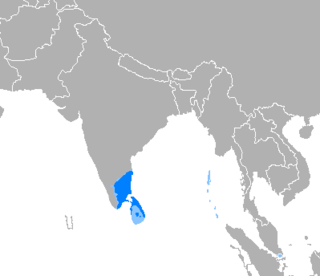 | |
Tamil[b] (தமிழ், Tamiḻ, pronounced [t̪amiɻ] ⓘ) is a Dravidian language natively spoken by the Tamil people of South Asia. Tamil is an official language of the Indian state of Tamil Nadu and union territory of Puducherry, and the sovereign nations of Sri Lanka and Singapore.[9][5] Tamil is also spoken by significant minorities in the four other South Indian states of Kerala, Karnataka, Andhra Pradesh and Telangana, and the Union Territory of the Andaman and Nicobar Islands. It is also spoken by the Tamil diaspora found in many countries, including Malaysia, Myanmar, South Africa, United Kingdom, United States, Canada, Australia, New Zealand, United Arab Emirates, Saudi Arabia, France, Germany, Italy, Indonesia, and Mauritius. Tamil is also natively spoken by the Sri Lankan Moors. One of 22 scheduled languages in the Constitution of India, Tamil was the first to be classified as a classical language of India.
Tamil is one of the longest-surviving classical languages in the world.[10][11] A. K. Ramanujan described it as "the only language of contemporary India which is recognizably continuous with a classical past".[12] The variety and quality of classical Tamil literature has led to it being described as "one of the great classical traditions and literatures of the world".[13] Recorded Tamil literature has been documented for over 2000 years.[14] The earliest period of Tamil literature, Sangam literature, is dated from c. 300 BC until AD 300.[15][16] It has the oldest extant literature among Dravidian languages. The earliest epigraphic records found on rock edicts and 'hero stones' date from around the 3rd century BC.[17][18] About 60,000 of the approximately 100,000 inscriptions found by the Archaeological Survey of India in India are in Tamil Nadu. Of them, most are in Tamil, with only about 5 percent in other languages.[19] Tamil language inscriptions written in Brahmi script have been discovered in Sri Lanka and on trade goods in Thailand and Egypt.[20][21] The two earliest manuscripts from India,[22][23] acknowledged and registered by the UNESCO Memory of the World register in 1997 and 2005, were written in Tamil.[24]
In 1578, Portuguese Christian missionaries published a Tamil prayer book in old Tamil script named Thambiran Vanakkam, thus making Tamil the first Indian language to be printed and published.[25] The Tamil Lexicon, published by the University of Madras, was one of the earliest dictionaries published in Indian languages.[26] According to a 2001 survey, there were 1,863 newspapers published in Tamil, of which 353 were dailies.[27]
Classification
Tamil belongs to the southern branch of the Dravidian languages, a family of around 26 languages native to the Indian subcontinent.[28] It is also classified as being part of a Tamil language family that, alongside Tamil proper, includes the languages of about 35 ethno-linguistic groups[29] such as the Irula and Yerukula languages (see SIL Ethnologue).
The closest major relative of Tamil is Malayalam; the two began diverging around the 9th century AD.[30] Although many of the differences between Tamil and Malayalam demonstrate a pre-historic divergence of the western dialect,[31] the process of separation into a distinct language, Malayalam, was not completed until sometime in the 13th or 14th century.[32]
History

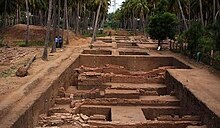
Tamil, like other Dravidian languages, ultimately descends from the Proto-Dravidian language, which was most likely spoken around the third millennium BC, possibly in the region around the lower Godavari river basin. The material evidence suggests that the speakers of Proto-Dravidian were of the culture associated with the Neolithic complexes of South India.[33]
Among Indian languages, Tamil has the most ancient non-Sanskritic Indian literature.[34] Scholars categorise the attested history of the language into three periods: Old Tamil (300 BC–AD 700), Middle Tamil (700–1600) and Modern Tamil (1600–present).[35] In November 2007, an excavation at Quseir-al-Qadim revealed Egyptian pottery dating back to first century BC with ancient Tamil Brahmi inscriptions.[20] There are a number of apparent Tamil loanwords in Biblical Hebrew dating to before 500 BC, the oldest attestation of the language.[36] John Guy states that Tamil was the lingua franca for early maritime traders from India.[37]
In 2004, a number of skeletons were found buried in earthenware urns dating from at least 696 BC in Adichanallur. Some of these urns contained writing in Tamil Brahmi script, and some contained skeletons of Tamil origin.[38]
Between 2017 and 2018, 5,820 artifacts have been found in Keezhadi. These were sent to Beta Analytic in Miami, Florida for Accelerator Mass Spectrometry (AMS) dating. One sample containing Tamil-Brahmi inscriptions was claimed to be dated to around 580 BC.[39][40]
Legend


According to Hindu legend, Tamil or in personification form Tamil Thāi (Mother Tamil) was created by Lord Shiva. Murugan, revered as the Tamil God, along with sage Agastya, brought it to the people.[45]
Etymology
The earliest extant Tamil literary works and their commentaries celebrate the Pandiyan Kings for the organization of long-termed Tamil Sangams, which researched, developed and made amendments in Tamil language. Even though the name of the language which was developed by these Tamil Sangams is mentioned as Tamil, the period when the name "Tamil" came to be applied to the language is unclear, as is the precise etymology of the name. The earliest attested use of the name is found in Tholkappiyam, which is dated as early as late 2nd century BC.[46][47] The Hathigumpha inscription, inscribed around a similar time period (150 BCE), by Kharavela, the Jain king of Kalinga, also refers to a Tamira Samghatta (Tamil confederacy)[48]
The Samavayanga Sutra dated to the 3rd century BC contains a reference to a Tamil script named 'Damili'.[49]
Southworth suggests that the name comes from tam-miḻ > tam-iḻ "self-speak", or "our own speech".[50] Kamil Zvelebil suggests an etymology of tam-iḻ, with tam meaning "self" or "one's self", and "-iḻ" having the connotation of "unfolding sound". Alternatively, he suggests a derivation of tamiḻ < tam-iḻ < *tav-iḻ < *tak-iḻ, meaning in origin "the proper process (of speaking)".[51] However, this is deemed unlikely by Southworth due to the contemporary use of the compound 'centamiḻ', which means refined speech in the earliest literature.[50]
The Tamil Lexicon of University of Madras defines the word "Tamil" as "sweetness".[52] S. V. Subramanian suggests the meaning "sweet sound", from tam — "sweet" and il — "sound".[53]
Old Tamil

Old Tamil is the period of the Tamil language spanning the 3rd century BC to the 8th century AD. The earliest records in Old Tamil are short inscriptions from 300 BC to 700 AD. These inscriptions are written in a variant of the Brahmi script called Tamil-Brahmi.[54] The earliest long text in Old Tamil is the Tolkāppiyam, an early work on Tamil grammar and poetics, whose oldest layers could be as old as the late 2nd century BC.[35][47] Many literary works in Old Tamil have also survived. These include a corpus of 2,381 poems collectively known as Sangam literature. These poems are usually dated to between the 1st century BC and 5th century AD.[35][47]
Middle Tamil

The evolution of Old Tamil into Middle Tamil, which is generally taken to have been completed by the 8th century,[35] was characterised by a number of phonological and grammatical changes. In phonological terms, the most important shifts were the virtual disappearance of the aytam (ஃ), an old phoneme,[55] the coalescence of the alveolar and dental nasals,[56] and the transformation of the alveolar plosive into a rhotic.[57] In grammar, the most important change was the emergence of the present tense. The present tense evolved out of the verb kil (கில்), meaning "to be possible" or "to befall". In Old Tamil, this verb was used as an aspect marker to indicate that an action was micro-durative, non-sustained or non-lasting, usually in combination with a time marker such as ṉ (ன்). In Middle Tamil, this usage evolved into a present tense marker – kiṉṟa (கின்ற) – which combined the old aspect and time markers.[58]
Modern Tamil
The Nannūl remains the standard normative grammar for modern literary Tamil, which therefore continues to be based on Middle Tamil of the 13th century rather than on Modern Tamil.[59] Colloquial spoken Tamil, in contrast, shows a number of changes. The negative conjugation of verbs, for example, has fallen out of use in Modern Tamil[60] – instead, negation is expressed either morphologically or syntactically.[61] Modern spoken Tamil also shows a number of sound changes, in particular, a tendency to lower high vowels in initial and medial positions,[62] and the disappearance of vowels between plosives and between a plosive and rhotic.[63]
Contact with European languages affected written and spoken Tamil. Changes in written Tamil include the use of European-style punctuation and the use of consonant clusters that were not permitted in Middle Tamil. The syntax of written Tamil has also changed, with the introduction of new aspectual auxiliaries and more complex sentence structures, and with the emergence of a more rigid word order that resembles the syntactic argument structure of English.[64] Simultaneously, a strong strain of linguistic purism emerged in the early 20th century, culminating in the Pure Tamil Movement which called for removal of all Sanskritic elements from Tamil.[65] It received some support from Dravidian parties.[66] This led to the replacement of a significant number of Sanskrit loanwords by Tamil equivalents, though many others remain.[67]
Geographic distribution
Tamil is the primary language of the majority of the people residing in Tamil Nadu, Puducherry, (in India) and in the Northern and Eastern provinces of Sri Lanka. The language is spoken among small minority groups in other states of India which include Karnataka, Telangana, Andhra Pradesh, Kerala, Maharashtra, Gujarat, Delhi, Andaman and Nicobar Islands in India and in certain regions of Sri Lanka such as Colombo and the hill country. Tamil or dialects of it were used widely in the state of Kerala as the major language of administration, literature and common usage until the 12th century AD. Tamil was also used widely in inscriptions found in southern Andhra Pradesh districts of Chittoor and Nellore until the 12th century AD.[68] Tamil was used for inscriptions from the 10th through 14th centuries in southern Karnataka districts such as Kolar, Mysore, Mandya and Bengaluru.[69]
There are currently sizeable Tamil-speaking populations descended from colonial-era migrants in Malaysia, Singapore, Philippines, Mauritius, South Africa, Indonesia,[70] Thailand,[71] Burma, and Vietnam. Tamil is used as one of the languages of education in Malaysia, along with English, Malay and Mandarin.[72][73] A large community of Pakistani Tamils speakers exists in Karachi, Pakistan, which includes Tamil-speaking Hindus[74][75] as well as Christians and Muslims – including some Tamil-speaking Muslim refugees from Sri Lanka.[76] There are about 100 Tamil Hindu families in Madrasi Para colony in Karachi. They speak impeccable Tamil along with Urdu, Punjabi and Sindhi.[77] Many in Réunion, Guyana, Fiji, Suriname, and Trinidad and Tobago have Tamil origins,[78] but only a small number speak the language. In Reunion where the Tamil language was forbidden to be learnt and used in public space by France it is now being relearnt by students and adults.[79] Tamil is also spoken by migrants from Sri Lanka and India in Canada, the United States (especially New Jersey and New York City), the United Arab Emirates, the United Kingdom, South Africa, and Australia.
Legal status
Tamil is the official language of the Indian state of Tamil Nadu and one of the 22 languages under schedule 8 of the constitution of India.[citation needed] It is one of the official languages of the union territories of Puducherry and the Andaman and Nicobar Islands.[80][81] Tamil is also one of the official languages of Singapore. Tamil is one of the official and national languages of Sri Lanka, along with Sinhala.[9] It was once given nominal official status in the Indian state of Haryana, purportedly as a rebuff to Punjab, though there was no attested Tamil-speaking population in the state, and was later replaced by Punjabi, in 2010.[82] In Malaysia, 543 primary education government schools are available fully in Tamil as the medium of instruction.[83] The establishment of Tamil-medium schools has been in process in Myanmar to provide education completely in Tamil language by the Tamils who settled there 200 years ago.[84] Tamil language is available as a course in some local school boards and major universities in Canada and the month of January has been declared "Tamil Heritage Month" by the Parliament of Canada.[85][86] Tamil enjoys a special status of protection under Article 6(b), Chapter 1 of the Constitution of South Africa and is taught as a subject in schools in KwaZulu-Natal province.[87][88] Recently, it has been rolled out as a subject of study in schools in the French overseas department of Réunion.[89]
In addition, with the creation in October 2004 of a legal status for classical languages by the Government of India and following a political campaign supported by several Tamil associations,[90][91] Tamil became the first legally recognised Classical language of India. The recognition was announced by the contemporaneous President of India, Abdul Kalam, who was a Tamilian himself, in a joint sitting of both houses of the Indian Parliament on 6 June 2004.[92][93][94]
Dialects
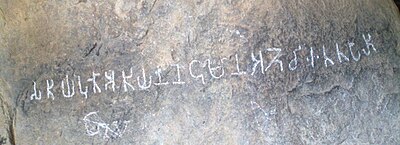
Region-specific variations
The socio-linguistic situation of Tamil is characterised by diglossia: there are two separate registers varying by socioeconomic status, a high register and a low one.[95][96] Tamil dialects are primarily differentiated from each other by the fact that they have undergone different phonological changes and sound shifts in evolving from Old Tamil. For example, the word for "here"—iṅku in Centamil (the classic variety)—has evolved into iṅkū in the Kongu dialect of Coimbatore, inga in the dialects of Thanjavur and Palakkad, and iṅkai in some dialects of Sri Lanka. Old Tamil's iṅkaṇ (where kaṇ means place) is the source of iṅkane in the dialect of Tirunelveli, Old Tamil iṅkiṭṭu is the source of iṅkuṭṭu in the dialect of Madurai, and iṅkaṭe in some northern dialects. Even now, in the Coimbatore area, it is common to hear "akkaṭṭa" meaning "that place". Although Tamil dialects do not differ significantly in their vocabulary, there are a few exceptions. The dialects spoken in Sri Lanka retain many words and grammatical forms that are not in everyday use in India,[35][97] and use many other words slightly differently.[98] Tamil dialects include Central Tamil dialect, Kongu Tamil, Madras Bashai, Madurai Tamil, Nellai Tamil, Kumari Tamil in India; Batticaloa Tamil dialect, Jaffna Tamil dialect, Negombo Tamil dialect in Sri Lanka; and Malaysian Tamil in Malaysia. Sankethi dialect in Karnataka has been heavily influenced by Kannada.
Loanword variations
The dialect of the district of Palakkad in Kerala has many Malayalam loanwords, has been influenced by Malayalam's syntax, and has a distinctive Malayalam accent. Similarly, Tamil spoken in Kanyakumari District has more unique words and phonetic style than Tamil spoken at other parts of Tamil Nadu. The words and phonetics are so different that a person from Kanyakumari district is easily identifiable by their spoken Tamil. Hebbar and Mandyam dialects, spoken by groups of Tamil Vaishnavites who migrated to Karnataka in the 11th century, retain many features of the Vaishnava paribasai, a special form of Tamil developed in the 9th and 10th centuries that reflect Vaishnavite religious and spiritual values.[99] Several castes have their own sociolects which most members of that caste traditionally used regardless of where they come from. It is often possible to identify a person's caste by their speech.[100] For example, Tamil Brahmins tend to speak a variety of dialects that are all collectively known as Brahmin Tamil. These dialects tend to have softer consonants (with consonant deletion also common). These dialects also tend to have many Sanskrit loanwords. Tamil in Sri Lanka incorporates loan words from Portuguese, Dutch, and English.
Spoken and literary variants
In addition to its dialects, Tamil exhibits different forms: a classical literary style modelled on the ancient language (sankattamiḻ), a modern literary and formal style (centamiḻ), and a modern colloquial form (koṭuntamiḻ). These styles shade into each other, forming a stylistic continuum. For example, it is possible to write centamiḻ with a vocabulary drawn from caṅkattamiḻ, or to use forms associated with one of the other variants while speaking koṭuntamiḻ.[101]
In modern times, centamiḻ is generally used in formal writing and speech. For instance, it is the language of textbooks, of much of Tamil literature and of public speaking and debate. In recent times, however, koṭuntamiḻ has been making inroads into areas that have traditionally been considered the province of centamiḻ. Most contemporary cinema, theatre and popular entertainment on television and radio, for example, is in koṭuntamiḻ, and many politicians use it to bring themselves closer to their audience. The increasing use of koṭuntamiḻ in modern times has led to the emergence of unofficial 'standard' spoken dialects. In India, the 'standard' koṭuntamiḻ, rather than on any one dialect,[102][clarification needed] but has been significantly influenced by the dialects of Thanjavur and Madurai. In Sri Lanka, the standard is based on the dialect of Jaffna.
Writing system
This section needs additional citations for verification. (June 2023) |
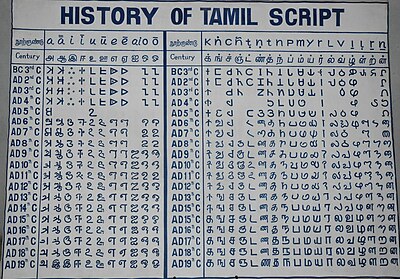

After Tamil Brahmi fell out of use, Tamil was written using a script called vaṭṭeḻuttu amongst others such as Grantha and Pallava. The current Tamil script consists of 12 vowels, 18 consonants and one special character, the āytam. The vowels and consonants combine to form 216 compound characters, giving a total of 247 characters (12 + 18 + 1 + (12 × 18)). All consonants have an inherent vowel a, as with other Indic scripts. This inherent vowel is removed by adding a tittle called a puḷḷi, to the consonantal sign. For example, ன is ṉa (with the inherent a) and ன் is ṉ (without a vowel). Many Indic scripts have a similar sign, generically called virama, but the Tamil script is somewhat different in that it nearly always uses a visible puḷḷi to indicate a 'dead consonant' (a consonant without a vowel). In other Indic scripts, it is generally preferred to use a ligature or a half form to write a syllable or a cluster containing a dead consonant, although writing it with a visible virama is also possible. The Tamil script does not differentiate voiced and unvoiced plosives. Instead, plosives are articulated with voice depending on their position in a word, in accordance with the rules of Tamil phonology.
In addition to the standard characters, six characters taken from the Grantha script, which was used in the Tamil region to write Sanskrit, are sometimes used to represent sounds not native to Tamil, that is, words adopted from Sanskrit, Prakrit, and other languages. The traditional system prescribed by classical grammars for writing loan-words, which involves respelling them in accordance with Tamil phonology, remains, but is not always consistently applied.[103] ISO 15919 is an international standard for the transliteration of Tamil and other Indic scripts into Latin characters. It uses diacritics to map the much larger set of Brahmic consonants and vowels to Latin script, and thus the alphabets of various languages, including English.
Numerals and symbols
Apart from the usual numerals, Tamil has numerals for 10, 100 and 1000. Symbols for day, month, year, debit, credit, as above, rupee, and numeral are present as well. Tamil also uses several historical fractional signs.
| zero | one | two | three | four | five | six | seven | eight | nine | ten | hundred | thousand |
|---|---|---|---|---|---|---|---|---|---|---|---|---|
| ௦ | ௧ | ௨ | ௩ | ௪ | ௫ | ௬ | ௭ | ௮ | ௯ | ௰ | ௱ | ௲ |
| day | month | year | debit | credit | as above | rupee | numeral |
|---|---|---|---|---|---|---|---|
| ௳ | ௴ | ௵ | ௶ | ௷ | ௸ | ௹ | ௺ |
Phonology
| Labial | Dental | Alveolar | Retroflex | Alveolo-palatal | Velar | Glottal | |
|---|---|---|---|---|---|---|---|
| Nasal | m ம் | (n̪) ந் | n ன் | ɳ ண் | ɲ ஞ் | (ŋ) ங் | |
| Stop/Affricate | p ப் | t̪ த் | (tːr ற்ற) | ʈ ட் | t͡ɕ ~ t͡ʃ ச்5 | k க் | |
| Fricative | (f)1 | s5 ஸ் (z)1 | (ʂ)1 ஷ் | (ɕ)1 ஶ் | (x)2 | (h)2 ஹ் | |
| Tap | ɾ ர் | ||||||
| Trill | r ற் | ||||||
| Approximant | ʋ வ் | ɻ ழ் | j ய் | ||||
| Lateral approximant | l ல் | ɭ ள் |
/f/, /z/, /ʂ/ and /ɕ/ are only found in loanwords and may be considered marginal phonemes, though they are traditionally not seen as fully phonemic.
| Front | Central | Back | ||||
|---|---|---|---|---|---|---|
| short | long | short | long | short | long | |
| Close | i இ | iː ஈ | u உ | uː ஊ | ||
| Mid | e எ | eː ஏ | o ஒ | oː ஓ | ||
| Open | ä அ | äː ஆ | ||||
Tamil has two diphthongs: /aɪ̯/ ஐ and /aʊ̯/ ஔ, the latter of which is restricted to a few lexical items.
Grammar
| Part of a series on |
| Tamils |
|---|
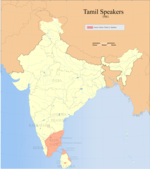 |
|
|
| Part of a series on |
| Dravidian culture and history |
|---|
 |

